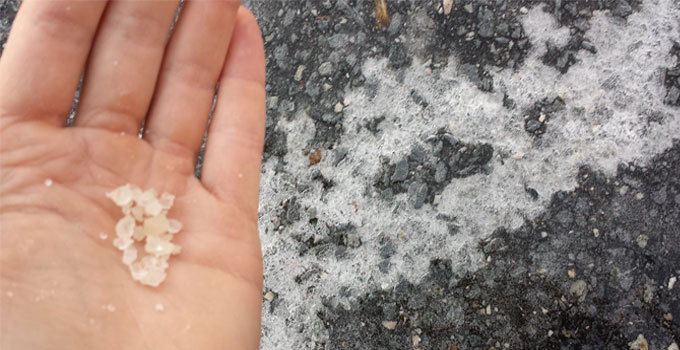Big bad four-wheel drive! It won’t help you on a sheet of ice.
For some, the only confidence booster they need is to see the flashing lights of a salt truck passing down the road.
Some states do it better than others, but once that salt hits the ground, the magic begins.
Like a Seventh Grade Science Project
Who has made homemade ice cream?
The combination of table salt and ice, in order to freeze milk, cream, and sugar will blow the minds of most 7th graders stuck in Chemistry class.
So what’s the trick?
Yes, when salt contacts the ice, it will begin to melt. But, the salt also lowers the freezing point of the ice, so the colder temperature can freeze the surrounding milk and cream below 32°F.
A lower freezing point! That’s the key to salting roads.
How Road Salt Really Works
Road salt melting ice on a parking lot.
When salt hits the road it will begin to melt any ice and snow, leaving a salty mixture layer on the road’s surface.
Since the salt lowers the freezing point, ice will not form at the typical freezing temperature (32°F, 0°C).
Instead, the new freezing point of this salty road mixture will be around 15° – 20°F.
One flaw: If the road temperature is below that 15° – 20°F level, the salt can’t do its job. Then it basically just provides some traction.
How Road Salt Is Made
Here’s a quick look at how road salt (rock salt) is made from the hit Discovery Channel show “How It’s Made.”
The Salt vs. Sand Controversy
Other than making slippery roads safer, road salt is a corrosive compound. Its corrosive effects on vehicles, road surfaces, and bridges are most often seen in the Northeast where more snow means more salt. Salt can also drain into nearby water supplies.
The alternative, sand, provides helpful traction in slick spots, but doesn’t always get the job done in harsher weather conditions. So those salt stock piles probably aren’t disappearing anytime soon.
Either way, the road crews are kept busy every year spreading over 15 million tons and
$2 billion (EPA, 2010) of salt to keep all four of your wheels on the pavement.
